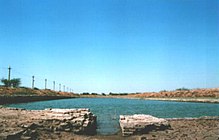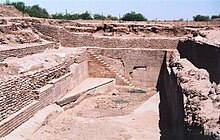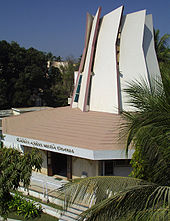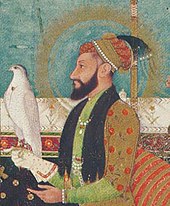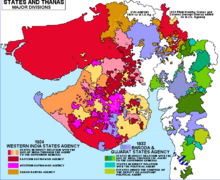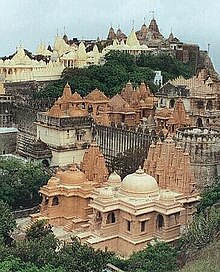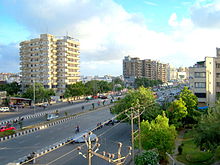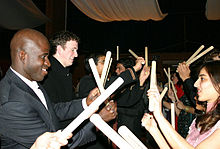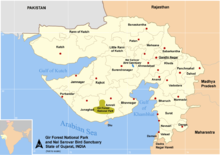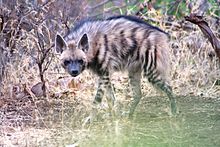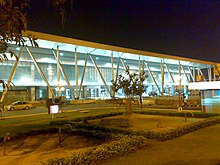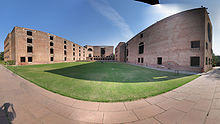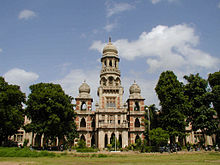GUJARAT INDIA
| Gujarat | ||
|---|---|---|
| State | ||
| ||
 Location of Gujarat in India | ||
Coordinates (Gandhinagar):  23°13′N 72°41′E 23°13′N 72°41′E | ||
| Country | ||
| Formation | 1 May 1960† | |
| Capital | Gandhinagar | |
| Largest city | Ahmedabad | |
| Districts | 33 | |
| Government | ||
| • Governor | Om Prakash Kohli | |
| • Chief Minister | Vijay Rupani (BJP) | |
| • Legislature | Unicameral (182 seats) | |
| • Parliamentary constituency | 26 | |
| • High Court | Gujarat High Court | |
| Area | ||
| • Total | 196,024 km2(75,685 sq mi) | |
| Area rank | 6th | |
| Population (2011) | ||
| • Total | 60,383,628 | |
| • Rank | 9th | |
| • Density | 308/km2 (800/sq mi) | |
| Demonym(s) | Gujarati | |
| Time zone | IST (UTC+05:30) | |
| ISO 3166 code | IN-GJ | |
| Vehicle registration | GJ | |
| HDI | ||
| HDI rank | 11th (2011) | |
| Literacy | 79.31% (2011 census) | |
| Official language | Gujarati[2] | |
Gujarat (/ˌɡʊdʒəˈrɑːt/ Gujǎrāt [ˈɡudʒ(ə)ɾaːt̪] ( listen)) is a state in Western India,[3] It has an area of 196,024 km2(75,685 sq mi) with a coastline of 1,600 km (990 mi), most of which lies on the Kathiawar peninsula, and a population in excess of 60 million. The state is bordered by Rajasthan to the north, Maharashtra to the south, Madhya Pradesh to the east, and the Arabian Sea and the Pakistani province of Sindh to the west. Its capital city is Gandhinagar, while its largest city is Ahmedabad. Gujarat is home to the Gujarati-speaking people of India.
listen)) is a state in Western India,[3] It has an area of 196,024 km2(75,685 sq mi) with a coastline of 1,600 km (990 mi), most of which lies on the Kathiawar peninsula, and a population in excess of 60 million. The state is bordered by Rajasthan to the north, Maharashtra to the south, Madhya Pradesh to the east, and the Arabian Sea and the Pakistani province of Sindh to the west. Its capital city is Gandhinagar, while its largest city is Ahmedabad. Gujarat is home to the Gujarati-speaking people of India.
The state encompasses some sites of the ancient Indus Valley Civilization, such as Lothal and Dholavira. Lothal is believed to be one of the world's first seaports. Gujarat's coastal cities, chiefly Bharuch and Khambhat, served as ports and trading centres in the Maurya and Gupta empires, and during the succession of royal Saka dynasties from the Western Satraps era.
Gujarat was known to the ancient Greeks, and was familiar in other Western centres of civilisation through the end of the European Middle Ages. The oldest written record of Gujarat's 2,000-year maritime history is documented in a Greek book titled The Periplus of the Erythraean Sea: Travel and Trade in the Indian Ocean by a Merchant of the First Century.[4][5]
Etymology
Modern-day Gujarat is derived from Sanskrit term Gurjaradesa, the Gurjar nation.[6][7][8] Parts of modern Rajasthan and Gujarat have been known as Gurjaratra or Gurjarabhumi (land of the Gurjars) for centuries before the Mughal period.[9]
History
Main article: History of Gujarat
Ancient history[edit]
Gujarat was one of the main centres of the Indus Valley Civilization. It contains ancient metropolitan cities from the Indus Valleysuch as Lothal, Dholavira, and Gola Dhoro. The ancient city of Lothal was where India's first port was established. The ancient city of Dholavira is one of the largest and most prominent archaeological sites in India, belonging to the Indus Valley Civilization. The most recent discovery was Gola Dhoro. Altogether, about 50 Indus Valley settlement ruins have been discovered in Gujarat.[10]
The ancient history of Gujarat was enriched by the commercial activities of its inhabitants. There is clear historical evidence of trade and commerce ties with Egypt, Bahrain and Sumer in the Persian Gulf during the time period of 1000 to 750 BC.[10][11]There was a succession of Hindu and Buddhist states such as the Mauryan Dynasty, Western Satraps, Satavahana dynasty, Gupta Empire, Chalukya dynasty, Rashtrakuta Empire, Pala Empire and Gurjara-Pratihara Empire, as well as local dynasties such as the Maitrakas and then the Chaulukyas.
The early history of Gujarat reflects the imperial grandeur of Chandragupta Maurya who conquered a number of earlier states in what is now Gujarat. Pushyagupta, a Vaishya, was appointed governor of Saurashtra by the Mauryan regime. He ruled Giringer (modern day Junagadh) (322 BC to 294 BC) and built a dam on the Sudarshan lake. Emperor Ashoka, the grandson of Chandragupta Maurya, not only ordered engraving of his edicts on the rock at Junagadh, but asked Governor Tusherpha to cut canals from the lake where an earlier Mauryan governor had built a dam. Between the decline of Mauryan power and Saurashtra coming under the sway of the Samprati Mauryas of Ujjain, there was an Indo-Greek incursion into Gujarat led by Demetrius. In the first half of the 1st century AD there is the story of a merchant of King Gondaphares landing in Gujarat with Apostle Thomas. The incident of the cup-bearer killed by a lion might indicate that the port city described is in Gujarat.[12][13]
For nearly 300 years from the start of the 1st century AD, Saka rulers played a prominent part in Gujarat's history. The weather-beaten rock at Junagadh gives a glimpse of the ruler Rudradaman I (100 AD) of the Saka satraps known as Western Satraps, or Kshatraps. Mahakshatrap Rudradaman I founded the Kardamaka dynasty which ruled from Anupa on the banks of the Narmada up to the Aparanta region which bordered Punjab. In Gujarat several battles were fought between the south Indian Satavahana dynasty and the Western Satraps. The greatest ruler of the Satavahana Dynasty was Gautamiputra Satakarni who defeated the Western Satraps and conquered some parts of Gujarat in the 2nd century CE.[14]
The Kshatrapa dynasty was replaced by the Gupta Empire with the conquest of Gujarat by Chandragupta Vikramaditya. Vikramaditya's successor Skandagupta left an inscription (450 AD) on a rock at Junagadh which gives details of the governor's repairs to the embankment surrounding Sudarshan lake after it was damaged by floods. The Anarta and Saurashtra regions were both part of the Gupta empire. Towards the middle of the 5th century, the Gupta empire went into decline. Senapati Bhatarka, the Maitraka general of the Guptas, took advantage of the situation and in 470 AD he set up what came to be known as the Maitraka state. He shifted his capital from Giringer to Valabhipur, near Bhavnagar, on Saurashtra's east coast. The Maitrakas of Vallabhi became very powerful with their rule prevailing over large parts of Gujarat and adjoining Malwa. A university was set up by the Maitrakas, which came to be known far and wide for its scholastic pursuits and was compared with the noted Nalanda university. It was during the rule of Dhruvasena Maitrak that Chinese philosopher-traveler Xuanzang visited in 640 AD along the Silk Road.[15]
Medieval history
In the early 8th century, the Arabs of the Umayyad Caliphate established an Empire in the name of the rising religion Islam, which stretched from Spain in the west to Afghanistan and modern-day Pakistan in the east. Al-Junaid, the successor of Qasim, finally subdued the Hindu resistance within Sindh and had established a secure base. The Arab rulers tried to expand their empire southeast, which culminated in the Caliphate campaigns in India fought in 730 CE. However, the Arab invaders were defeated and repelled from the areas east of the Indus river by a Hindu alliance between the north Indian Gurjar Emperor Nagabhata I of the Pratihara Dynasty, the south Indian Emperor Vikramaditya II of the Chalukya dynasty and many other local small Hindu kingdoms. After this victory, the Arab invaders were driven out of Gujarat. General Pulakesi, a Chalukya prince of Lata, received the title Avanijanashraya (refuge of the people of the earth) and honorific of "Repeller of the unrepellable" by the south Indian Emperor Vikramaditya II of the Chalukya dynasty for the protection of Gujarat during the battle at Navsari, where Syrian troops suffered a crushing defeat.[16]
In the late 8th century, the Kannauj Triangle period started. The three major Indian dynasties – the northwest Indian Gurjara-Pratihara Dynasty, the south Indian Rashtrakuta Dynasty and the east Indian Pala Empire – dominated India from the 8th to 10th centuries. During this period the northern part of Gujarat was ruled by the north Indian Gurjara-Pratihara dynasty and the southern part of Gujarat was ruled by the south Indian Rashtrakuta dynasty.[17] However, the earliest epigraphical records of the Gurjars of Broach attest that the royal bloodline of the Gurjara-Pratihara dynasty of Dadda I-II-III (650–750) ruled south Gujarat.[18] Southern Gujarat was ruled by the south Indian Rashtrakuta dynasty until it was captured by the south Indian ruler Tailapa II of the Western Chalukya Empire.[19]
Zoroastrians from Greater Iran migrated to the western borders of South Asia (Gujarat and Sindh) during the 8th or 10th century,[20] to avoid persecution by Musliminvaders who were in the process of conquering Iran. The descendants of those Zoroastrian refugees came to be known as the Parsi.[21][22][23][24]
Rajput Period
In the early 8th century some parts of Gujarat was ruled by the south Indian Chalukya dynasty. In the early 8th century the Arabs of the Umayyad Caliphate established an Empire which stretched from Spain in the west to Afghanistan and Pakistan in the east. The Arab rulers tried to expand their empire in the 8th century and invaded Gujarat but the Arab invaders were defeated by the south Indian general Pulakesi who was sent by the south Indian Emperor Vikramaditya II of the Chalukya Dynasty. After this victory the Arab invaders were driven out of Gujarat. Pulakesi received the title Avanijanashraya (refuge of the people of the earth) by Vikramaditya II for the protection of Gujarat. In the late 8th century the Kannauj Triangle period started. The 3 major Indian Dynasties the northwest Indian Gurjara-Pratihara Dynasty, the south Indian Rashtrakuta Dynastyand the east Indian Pala Empire dominated India from the 8th to 10th centuries. During this period the northern part of Gujarat was ruled by the north Indian Gurjara-Pratihara Dynasty and the southern part of Gujarat was ruled by the south Indian Rashtrakuta Dynasty.[17] Southern Gujarat was ruled by the south Indian Rashtrakuta dynasty until it was captured by the south Indian ruler Tailapa II of the Western Chalukya Empire.[19]
The Chaulukya dynasty [25] ruled Gujarat from c. 960 to 1243. Gujarat was a major centre of Indian Ocean trade, and their capital at Anhilwara (Patan) was one of the largest cities in India, with population estimated at 100,000 in the year 1000. In 1026, the famous Somnath temple in Gujarat was destroyed by Mahmud of Ghazni. After 1243, the Solankis lost control of Gujarat to their feudatories, of whom the Vaghela chiefs of Dholka came to dominate Gujarat. In 1292 the Vaghelas became tributaries of the Yadava dynasty of Devagiri in the Deccan. Karandev of the Vaghela dynasty was the last Hindu ruler of Gujarat. He was defeated and overthrown by the superior forces of Allauddin Khilji from Delhi in 1297. With his defeat Gujarat not only became part of the Muslim empire but the Rajput hold over Gujarat lost for ever.
Muslim rule
Islamic Conquests 1197–1614 AD
After the Ghoris had assumed a position of Muslim supremacy over North India, Qutbuddin Aibak attempted to conquer Gujarat and annex it to his empire in 1197 but failed in his ambitions.[26] An independent Muslim community continued to flourish in Gujarat for the next hundred years, championed by Arab merchants settling along the western coast belonging to the Shafi'ite madhhab.[27] From 1297 to 1300, Allauddin Khilji, the Turkic Sultan of Delhi, destroyed the Hindu metropolis of Anhilwara and incorporated Gujarat into the Delhi Sultanate. After Timur's sacking of Delhi at the end of the 14th century weakened the Sultanate, Gujarat's Muslim Rajputgovernor Zafar Khan Muzaffar (Muzaffar Shah I) asserted his independence, and his son, Sultan Ahmed Shah (ruled 1411 to 1442), established Ahmedabad as the capital. Khambhat eclipsed Bharuch as Gujarat's most important trade port. Gujarat's relations with Egypt, which was then the premier Arab power in the Middle East remained friendly over the next century and the Egyptian scholar, Badruddin-ad-Damamimi, spent several years in Gujarat in the shade of the Sultan before proceeding to the Bahmani Sultanate of the Deccan.[28]
Shah e Alam, a famous Sufi-saint of the Chishti order who was the descendant of Makhdoom Jahaniyan Jahangasht from Bukharasoon arrived among other luminaries such as Arab theologian Ibn Suwaid, several Sayyid Sufi members of the Aydarus family of Tarimin Yemen,[29] Iberian court interpreter Ali al-Andalusi from Granada,[30] and the Arab jurist Bahraq from Hadramaut who was appointed a tutor of the prince.[31] Among the illustrious names who arrived during the reign of Mahmud Begada were the philosopher Haibatullah Shah Mir from Shiraz, and the scholar intellectual Abu Fazl Ghazaruni from Persia[32][33] who tutored and adopted Abu'l-Fazl ibn Mubarak, author of the Akbarnama.[34] Later, a close alliance between the Ottoman Turks and Gujarati sultans to effectively safeguard Jeddah and the Red Sea trade from Portuguese imperialism, encouraged the existence of powerful Rumi elites within the kingdom who took the post of viziers in Gujarat keen to maintain ties with the Ottoman state.[35][36][37][38][39]
Humayun had also briefly occupied the province in 1536, but fled due to the threat Bahadur Shah, the Gujarat king, imposed.[40] The Sultanate of Gujarat remained independent until 1572, when the Mughal emperor Akbar the Great conquered it and annexed it to the Mughal Empire.[41]
The Surat port (the only Indian port facing westwards) then became the principal port of India during Mughal rule to gain widespread international repute. The eminent city of Surat, famous for its cargo export of silk and diamonds had come on a par with contemporary Venice and Beijing which were some of the great mercantile cities of Europe and Asia,[42] and earned the distinguished title, Bab al-Makkah (Gate of Mecca).[43][44]
Drawn by the religious renaissance taking place under Akbar, Mohammed Ghaus moved to Gujarat and established spiritual centres for the Shattari Sufi order from Iran, founding the Ek Toda Mosque and producing such devotees as Wajihuddin Alvi of Ahmedabad whose many successors moved to Bijapur during the height of the Adil Shahi dynasty.[45] At the same time, Zoroastrian high priest Azar Kayvan who was a native of Fars, immigrated to Gujarat founding the Zoroastrian school of illuminationists which attracted key Shi'ite Muslim admirers of the Safavid philosophical revival from Isfahan.
Early 14th-century Maghrebi adventurer, Ibn Batuta, who famously visited India with his entourage, recalls in his memoirs about Cambay, one of the great emporia of the Indian Ocean that indeed:
Cambay is one of the most beautiful cities as regards the artistic architecture of its houses and the construction of its mosques. The reason is that the majority of its inhabitants are foreign merchants, who continually build their beautiful houses and wonderful mosques – an achievement in which they endeavor to surpass each other.
Many of these "foreign merchants" were transient visitors, men of South Arabian and Persian Gulf ports, who migrated in and out of Cambay with the rhythm of the monsoons. But others were men with Arab or Persian patronyms whose families had settled in the town generations, even centuries earlier, intermarrying with Gujarati women, and assimilating everyday customs of the Hindu hinterland.[46]
The Age of Discovery heralded the dawn of pioneer Portuguese and Spanish long-distance travel in search of alternative trade routes to "the East Indies", moved by the trade of gold, silver and spices. In 1497, Portuguese explorer Vasco da Gama is said to have discovered the Europe-to-India sea route which changed the course of history, thanks to Kutchi sailor Kanji Malam, who showed him the route from the East African coasts of Mozambique sailing onwards to Calicut off the Malabar coast in India.[47][48][49] Later, the Gujarat Sultanate allied with the Ottomans and Egyptian Mamluks naval fleets led by governor-generals Malik Ayyaz and Amir Husain Al-Kurdi, vanquished the Portuguese in the 1508 Battle of Chaul resulting in the first Portuguese defeat at sea in the Indian Ocean.[50]
To 16th-century European observers, Gujarat was a fabulously wealthy country. The customs revenue of Gujarat alone in the early 1570s was nearly three times the total revenue of the whole Portuguese empire in Asia in 1586–87, when it was at its height.[51] Indeed, when the British arrived on the coast of Gujarat, houses in Surat already had windows of Venetian glass imported from Constantinople through the Ottoman empire.[52] In 1514, the Portuguese explorer Duarte Barbosa described the cosmopolitan atmosphere of Rander known otherwise as City of Mosques in Surat province, which gained the fame and reputation of illustrious Islamic scholars, Sufi-saints, merchants and intellectuals from all over the world:[53]
Ranel (Rander) is a good town of the Moors, built of very pretty houses and squares. It is a rich and agreeable place ... the Moors of the town trade with Malacca, Bengal, Tawasery (Tannasserim), Pegu, Martaban, and Sumatra in all sort of spices, drugs, silks, musk, benzoin and porcelain. They possess very large and fine ships and those who wish Chinese articles will find them there very completely. The Moors of this place are white and well dressed and very rich they have pretty wives, and in the furniture of these houses have china vases of many kinds, kept in glass cupboards well arranged. Their women are not secluded like other Moors, but go about the city in the day time, attending to their business with their faces uncovered as in other parts.
The conquest of the Kingdom of Gujarat marked a significant event of Akbar's reign. Being the major trade gateway and departure harbour of pilgrim ships to Mecca, it gave the Mughal Empire free access to the Arabian sea and control over the rich commerce that passed through its ports. The territory and income of the empire were vastly increased.[54]
The Sultanate of Gujarat and the merchants
For the best part of two centuries, the independent Rajput Sultanate of Gujarat was the cynosure of its neighbours on account of its wealth and prosperity, which had long made the Gujarati merchant a familiar figure in the ports of the Indian Ocean.[55] Gujaratis, including Hindus and Muslims as well as the enterprising Parsi class of Zoroastrians, had been specialising in the organisation of overseas trade for many centuries, and had moved into various branches of commerce such as commodity trade, brokerage, money-changing, money-lending and banking.[56]
By the 17th century, Chavuse and Baghdadi Jews had assimilated into the social world of the Surat province, later on their descendants would give rise to the Sassoons of Bombay and the Ezras of Calcutta, and other influential Indian-Jewish figures who went on to play a philanthropical role in the commercial development of 19th-century British Crown Colony of Shanghai.[57]Spearheaded by Khoja, Bohra, Bhatiya shahbandars and Moorish nakhudas who dominated sea navigation and shipping, Gujarat's transactions with the outside world had created the legacy of an international transoceanic empire which had a vast commercial network of permanent agents stationed at all the great port cities across the Indian Ocean. These networks extended to the Philippinesin the east, East Africa in the west, and via maritime and the inland caravan route to Russia in the north.[58]
As Tome Pires, a Portuguese official at Malacca, writing of conditions during the reigns of Mahmud I and Mozaffar II, expressed it: "Cambay stretches out two arms; with her right arm she reaches toward Aden and with the other towards Malacca" (Pires, I, p. 41) and also described Gujarat's active trade with Goa, Deccan and the Malabar. His contemporary, Duarte Barbosa, describing Gujarat's maritime trade, recorded the import of horses from the Middle East and elephants from Malabar, and lists exports which included muslins, chintzes and silks, carnelian, ginger and other spices, aromatics, opium, indigo and other substances for dyeing, cereals and legumes (Barbosa, I, pp. 108–58). Persia was the destination for many of these commodities, and they were partly paid for in horses and pearls taken from Hormuz (Barbosa, I, p. 82). It was the latter item, in particular, which led Sultan Sikandar Lodi of Delhi, according to Ali-Muhammad Khan, author of the Mirat-i-Ahmadi, to complain that the "support of the throne of Delhi is wheat and barley but the foundation of the realm of Gujarat is coral and pearls" (apud Bayley, p. 20). Hence, the sultans of Gujarat possessed ample means to sustain lavish patronage of religion and the arts, to build madrasas and ḵānaqāhs, and to provide douceurs for the literati, mainly poets and historians, whose presence and praise enhanced the fame of the dynasty.[59]
Even at the time of Tom Pires' travel to the East Indies in the early 16th century, Gujarati merchants had earned an international reputation for their commercial acumen and this encouraged the visit of merchants from Cairo, Armenia, Abyssinia, Khorasan, Shiraz, Turkestan and Guilans from Aden and Hormuz.[60] Pires noted in his Suma Orientale:[61]
These [people] are [like] Italians in their knowledge of and dealings in merchandise ... they are men who understand merchandise; they are so properly steeped in the sound and harmony of it, that the Gujaratees say that any offence connected with merchandise is pardonable. There are Gujaratees settled everywhere. They work some for some and others for others. They are diligent, quick men in trade. They do their accounts with fingers like ours and with our very writings.
Gujarat in the Mughal Empire
Gujarat was one of the twelve original subahs (imperial top-level provinces) established by Mughal padshah (emperor) Akbar the Great, with seat at Ahmedabad, bordering on Thatta (Sindh), Ajmer, Malwa and later Ahmadnagar subahs.
Aurangzeb, who was better known by his imperial title Alamgir ("Conqueror of the World"), was born at Dahod, Gujarat, and was the sixth Mughal Emperor ruling with an iron fist over most of the Indian subcontinent. He was the third son and sixth child of Shah Jahanand Mumtaz Mahal. At the time of his birth, his father, Shah Jahan, was then the Subahdar (governor) of Gujarat, and his grandfather, Jehangir, was the Mughal Emperor. Before he became emperor, Aurangzeb was made Subahdar of Gujarat subah as part of his training and was stationed at Ahmedabad. Aurangzeb was a notable expansionist and was amongst the wealthiest of the Mughal rulers, with an annual yearly tribute of £38,624,680 (in 1690). During his lifetime, victories in the south expanded the Mughal Empire to more than 3.2 million square kilometres and he ruled over a population estimated as being in the range of 100–150 million subjects.
Aurangzeb had great love for his place of birth. In 1704, he wrote a letter to his eldest son, Muhammad Azam Shah, asking him to be kind and considerate to the people of Dahod as it was his birthplace. Muhammad Azam was then the Subedar (governor) of Gujarat.
In his letter, Aurangzeb wrote:[62]
My son of exalted rank, the town of Dahod, one of the dependencies of Gujarat, is the birthplace of this sinner. Please consider a regard for the inhabitants of that town as incumbent on you.
Maratha Empire
| This section does not cite any sources. Please help improve this section by adding citations to reliable sources. Unsourced material may be challenged and removed. (April 2017) (Learn how and when to remove this template message) |
When the cracks had started to develop in the edifice of the Mughal empire in the mid-17th century, the Marathas were consolidating their power in the west, Chatrapati Shivaji, the great Maratha ruler, attacked Surat twice first in 1664 and again in 1672. These attacks marked the entry of the Marathas into Gujarat. However, before the Maratha inroads into Gujarat, the Europeans had made their presence felt, with the Portuguese leading them, followed by the Dutch and the English.
The Peshwas had established their sovereignty over Gujarat including Saurashtra, and collected taxes and tributes through their representatives. Damaji Gaekwad and Kadam Bande divided the Peshwa's territory between them, with Damaji establishing the sway of Gaekwad over Gujarat and made Baroda (present day Vadodara) his capital. The ensuing internecine war among the Marathas were fully exploited by the British, who interfered in the affairs of both Gaekwads and the Peshwas.
European Colonialism 1614–1947 AD
In the 1600s, the Dutch, French, English and Portuguese all established bases along the western coast of the region. Portugal was the first European power to arrive in Gujarat, and after the Battle of Diu and Treaty of Bassein, acquired several enclaves along the Gujarati coast, including Daman and Diu as well as Dadra and Nagar Haveli. These enclaves were administered by Portuguese India under a single union territory for over 450 years, only to be later incorporated into the Republic of India on 19 December 1961 by military conquest.
The British East India Company established a factory in Surat in 1614 following the commercial treaty made with Mughal Emperor Nuruddin Salim Jahangir, which formed their first base in India, but it was eclipsed by Bombay after the English received it from Portugal in 1668 as part of the marriage treaty of Charles II of England and Catherine of Braganza, daughter of King John IV of Portugal. The state was an early point of contact with the west, and the first British commercial outpost in India was in Gujarat.[63]
17th-century French explorer François Pyrard de Laval, who is remembered for his 10-year sojourn in South Asia, bears witness accounts that the Gujaratis were always prepared to learn workmanship from the Portuguese, also in turn imparting skills to the Portuguese:[64]
I have never seen men of wit so fine and polished as are these Indians: they have nothing barbarous or savage about them, as we are apt to suppose. They are unwilling indeed to adopt the manners and customs of the Portuguese; yet do they regularly learn their manufactures and workmanship, being all very curious and desirous of learning. In fact the Portuguese take and learn more from them than they from the Portuguese.
Later in the 17th century, Gujarat came under control of the Hindu Maratha Empire that rose defeating the Muslim Mughals and who dominated the politics of India. Most notably, from 1705 to 1716, Senapati Khanderao Dabhade led the Maratha Empire forces in Baroda. Pilaji Gaekwad, first ruler of Gaekwad dynasty, established the control over Baroda and other parts of Gujarat.
The British East India Company wrested control of much of Gujarat from the Marathas during the Second Anglo-Maratha Warin 1802–1803. Many local rulers, notably the Rajput Maratha Gaekwad Maharajas of Baroda (Vadodara), made a separate peace with the British and acknowledged British sovereignty in return for retaining local self-rule.
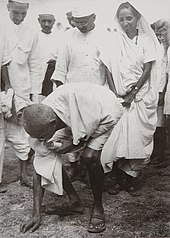
Mahatma Gandhi picking salt at Dandi beach, South Gujarat ending the Salt satyagraha on 5 April 1930
Gujarat was placed under the political authority of the Bombay Presidency, with the exception of Baroda state, which had a direct relationship with the Governor-General of India. From 1818 to 1947, most of present-day Gujarat, including Kathiawar, Kutch and northern and eastern Gujarat were divided into hundreds of princely states, but several districts in central and southern Gujarat, namely Ahmedabad, Broach (Bharuch), Kaira (Kheda), Panchmahal and Surat, were governed directly by British officials.
Post independence
After Indian independence and the partition of India in 1947, the new Indian government grouped the former princely states of Gujarat into three larger units; Saurashtra, which included the former princely states on the Kathiawad peninsula, Kutch, and Bombay state, which included the former British districts of Bombay Presidency together with most of Baroda state and the other former princely states of eastern Gujarat. Bombay state was enlarged to include Kutch, Saurashtra (Kathiawar) and parts of Hyderabad state and Madhya Pradesh in central India. The new state had a mostly Gujarati-speaking north and a Marathi-speaking south. Agitation by Gujarati nationalists, the Mahagujarat Movement, and Marathi nationalists, the Samyukta Maharashtra, for their own states led to the split of Bombay state on linguistic lines; on 1 May 1960, it became the new states of Gujarat and Maharashtra. In 1969 riots, at least 660 died and properties worth millions were destroyed.[65][66]
The first capital of Gujarat was Ahmedabad; the capital was moved to Gandhinagar in 1970. Nav Nirman Andolan was a socio-political movement of 1974. It was a students' and middle-class people's movement against economic crisis and corruption in public life. This was the first and last successful agitation after the Independence of India that ousted an elected government.[67][68][69]
The Morvi dam failure, in 1979, resulted in the death of thousands of people and large economic loss.[70] In the 1980s, a reservation policy was introduced in the country, which led to anti-reservation protests in 1981 and 1985. The protests witnessed violent clashes between people belonging to various castes.[71]
The 2001 Gujarat earthquake was located about 9 km south-southwest of the village of Chobari in Bhachau Taluka of Kutch District. This magnitude 7.7 shock killed around 20,000 people (including at least 18 in South-eastern Pakistan), injured another 167,000 and destroyed nearly 400,000 homes.[72]
In February 2002, the Godhra Train Attack lead to statewide riots, resulting in the deaths of 1044 people – 790 Muslims and 254 Hindus, and hundreds missing still unaccounted for.[73] Akshardham Temple was attacked by two terrorists in September 2002, killing 32 persons and injuring more than 80 others. National Security Guards intervented to end siege killing both terrorists.[74] On 26 July 2008 a series of seventeen bomb blasts rocked the city, killing and injuring several people.[75]
Geography
Main article: Geography of Gujarat
See also: Climate of Gujarat and List of rivers of Gujarat
Gujarat borders Pakistan's Sindh province to the northwest, is bounded by the Arabian Sea to the southwest, the state of Rajasthan to the northeast, Madhya Pradesh to the east, and by Maharashtra, Union territories of Diu, Daman, Dadra and Nagar Haveli to the south. Historically, the north was known as Anarta, the Kathiawar peninsula, "Saurastra", and the south as "Lata".[76] Gujarat was also known as Pratichya and Varuna.[77] The Arabian Sea makes up the state's western coast. The capital, Gandhinagar is a planned city. Gujarat has an area of 75,686 sq mi (196,030 km2) with the longest coast line(24% of Indian sea coast) 1,600 kilometres (990 mi), dotted with 41 ports: one major, 11 intermediate and 29 minor.
The Sabarmati is the largest river in Gujarat followed by the Tapi, although the Narmada covers the longest distance in its passage through the state. The Sardar Sarovar Project is built on the Narmada River, one of the major rivers of peninsular India with a length of around 1,312 kilometres (815 mi). It is one of only three rivers in peninsular India that run from east to west – the others being the Tapi River and the Mahi River. A riverfront project has been built on the Sabarmati River.
Rann of Kutch
Main article: Rann of Kutch
The Rann of Kutch is a seasonally marshy saline clay desert located in the Thar Desert biogeographic region in between the province of Sindh and the state of Gujarat. Situated 8 kilometres (5.0 mi) from the village of Kharaghoda in the Surendranagar District and Pakistan's Sindh province. The name "Rann" comes from the Hindi word ran (रण) meaning "salt marsh".
Demographics
Main article: Gujarati people
The population of Gujarat State was 60,383,628, according to the 2011 census data. The population density is 308 km−2 (797.6/sq mi), lower than other Indian states. As per the census of 2011, the state has a sex ratio of 918 girls for every 1000 boys, one of the lowest (ranked 24) amongst the 29 states in India.
While Gujarati speakers constitute a majority of Gujarat's population, the metropolitan areas of Ahmedabad and Surat are cosmopolitan, with numerous other ethnic and language groups. Marwaris and Biharis compose large minorities of economic migrants; smaller communities of Nepalese, Portuguese, South Koreans, Tamils, Odias, Telugus, Assamese, Bengali, Anglo-Indians, Armenians, Greeks, Jews, Tibetans, Maharashtrians, Kannadigas, Konkanis, Malayalees, Punjabis, and Parsis also live in the area[citation needed]. The South Korean community traditionally worked in the local tanning industry and ran restaurants. Sindhi presence is traditionally important here following the loss of their province post-Partition.[79]
Religion

Religion in Gujarat (2011)[80]
Hinduism (88.57%)
Islam (9.67%)
Jainism (0.96%)
Christianity (0.52%)
Sikhism (0.10%)
Buddhism (0.05%)
Others (0.03%)
Not stated (0.10%)
According to 2011 census, the religious makeup in Gujarat was 88.6% Hindu, 9.7% Muslim, 1.0% Jain, 0.5% Christian, 0.1% Sikh, 0.05% Buddhist and 0.03% others. Around 0.1% did not state any religion.[80] Hinduism is the major religion of the state, as about 89% population of the state is Hindu. A major part of the Hindu population follow Vaishnavism.[citation needed] Muslims are the biggest minority in the state accounting for 9.5% of the population. Gujarat has the third-largest population of Jains in India, following Maharashtra and Rajasthan.[80]
The Zoroastrians, also known in India as Parsi and Irani, are believed to have migrated to Gujarat to escape adverse conditions in Persia and maintain their traditions. They have also played an instrumental role in economic development, with several of the best-known business conglomerates of India run by Parsi-Zoroastrians, including the Tata, Godrej, and Wadia families. There is a small Jewish community centred around Magen Abraham Synagogue.
- Magen Abraham Jewish Synagogue
- Jama Masjid (Friday Mosque, 15th century), Ahmedabad
- Modhera Sun Templebuilt by Bhimdev I
Language
Main article: Gujarati language
Gujarati (ગુજરાતી Gujǎrātī?) is an Indo-Aryan language evolved from Sanskrit and local Prakrits, and is part of the greater Indo-European language family. It is native to the Indian state of Gujarat, and is its main language, as well as of the adjacent union territories of Daman and Diu and Dadra and Nagar Haveli.
About 59 million people speak Gujarati, making it the 26th most-spoken native language in the world. Along with Romani, Kutchi, and Sindhi, it is amongst the most western of Indo-Aryan languages.
The majority of the population in the state can speak Gujarati. People from the Kutch region of Gujarat also speak in the Kutchimother tongue, and to a great extent appreciate Sindhi as well. Memoni is the mother tongue of Kathiawar and Sindhi Memons, most of them who are exclusively Muslims.
Almost 88% of the Gujarati Muslims speak Gujarati as their mother tongue, whilst the other 12% speak Urdu. A sizeable proportion of Gujarati Muslims are bilingual in both languages; Islamic academic institutions (Darul Uloom) place a high prestige on learning Urdu and Arabic, with students' memorising the Quran and ahadith, and emphasising the oral and literary importance of mastering these languages as a compulsory rite of religion. Other native languages spoken in low proportions are Bhili and Gamit, which are spoken exclusively among the tribals.[citation needed]
Apart from this, English, Marwari, Sindhi, Punjabi, Tamil, Kannada, Telugu, Bengali, Odia, Malayalam, Marathi and others are spoken by a considerable number of economic migrants who have flocked to the state in recent decades seeking employment and higher standards of living.
Governance and administration[edit]
Main articles: Politics of Gujarat, Government of Gujarat, Gujarat Legislative Assembly, and Districts of Gujarat
See also: Chief Ministers of Gujarat

Gandhinagar, the capital of Gujarat State. The picture shown above is of the Legislative Assembly and seat of Gujarat government.
Gujarat has 33 districts and 249 Talukas.[81]
Gujarat is governed by a Legislative Assembly of 182 members. Members of the Legislative Assembly are elected on the basis of adult suffrage from one of 182 constituencies, of which 13 are reserved for scheduled castes and 27 for scheduled tribes. The term of office for a member of the Legislative Assembly is five years. The Legislative Assembly elects a speaker who presides over the meetings of the legislature. A governor is appointed by the President of India, and is to address the state legislature after every general election and the commencement of each year's first session of the Legislative Assembly. The leader of the majority party or coalition in the legislature (Chief Minister) or his or her designee acts as the Leader of the Legislative Assembly. The administration of the state is led by the Chief Minister.
After the independence of India in 1947, the Indian National Congress (INC) ruled the Bombay State (which included present-day Gujarat and Maharashtra). Congress continued to govern Gujarat after the state's creation in 1960.
During and after India's State of Emergency of 1975–1977, public support for the INC eroded, but it continued to hold government until 1995 with brief rule of nine months by Janata Morcha. In the 1995 Assembly elections, the Congress lost to the Bharatiya Janata Party (BJP) led by Keshubhai Patel who became the Chief Minister. His government lasted only two years. The fall of that government was provoked by a split in the BJP led by Shankersinh Vaghela. BJP again won election in 1998 with clear majority. In 2001, following the loss of two assembly seats in by-elections, Keshubhai Patel resigned and yielded power to Narendra Modi. BJP retained a majority in the 2002 election, and Narendra Modi remained as Chief Minister. On 1 June 2007, Narendra Modi became the longest serving Chief Minister of Gujarat.[82][83][84] BJP retained the power in subsequent elections in 2007 and 2012 and Narendra Modi continued as the Chief Minister. After Narendra Modi became the Prime Minister of India in 2014, Anandiben Patel became the first female Chief Minister of the state.Vijay Rupani took over as Chief Minister and Nitin Patel as Dy. Chief Minister on 7 August 2016 after Anandiben Patel resigned earlier on 3 August.
Economy[edit]
| This section needs to be updated. Please update this article to reflect recent events or newly available information.(October 2016) |
Main article: Economy of Gujarat
During the British Raj, Gujarati businesses served to play a major role to enrich the economy of Karachi and Mumbai.[85] Major agricultural produce of the state includes cotton, groundnuts (peanuts), dates, sugar cane, milk and milk products. Industrial products include cement and petrol.[86] According to a 2009 report on economic freedom by the Cato Institute, Gujarat is the first most free state in India (the second one being Tamil Nadu).[87] Reliance Industries operates the oil refinery at Jamnagar, which is the world's largest grass-roots refinery at a single location. The world's largest shipbreaking yard is in Gujarat near Bhavnagar at Alang. India's only Liquid Chemical Port Terminal at Dahej, developed by Gujarat Chemical Port Terminal Co Ltd. Gujarat has two of the three liquefied natural gas (LNG) terminals in the country (Dahej and Hazira). Two more LNG terminals are proposed, at Pipavav and Mundra.
Gujrat has 85% village connectivity with all‐weather roads.[88] Nearly 100% of Gujarat's 18,000 villages have been connected to the electrical grid for 24-hour power to households and eight hours of power to farms, through the Jyotigram Yojana.[89] As of 2015, Gujarat ranks first nationwide in gas-based thermal electricity generation with a national market share of over 8%, and second nationwide in nuclear electricity generation with national market share of over 1%.[90]
More than 900,000 internet users and all villages are connected with broadband internet.[citation needed] The state registered 12.8% agricultural growth in the last five years against the national average of 2%.[91]
Gujarat records highest decadal agricultural growth rate of 10.97%. Over 20% of the S&P CNX 500 conglomerates have corporate offices in Gujarat.[92] As per RBI report, in year 2006–07, 26% out of total bank finance in India was in Gujarat.
In a July 2011 report, The Economist referred to Gujarat as India's Guangdong.
Infrastructure[edit]
Tallest tower in Gujarat, GIFT One was inaugurated on 10 January 2013. One other tower called GIFT Two has been finished and more towers are planned.[93]
Industrial growth[ed
Gujarat's major cities include Ahmedabad, Surat, Vadodara, Rajkot, Jamnagar and Bhavnagar. In 2010, Forbes list of the world's fastest growing cities included Ahmedabad at number 3 after Chengdu and Chongqing from China.[95][96] The state is rich in calcite, gypsum, manganese, lignite, bauxite, limestone, agate, feldspar, and quartz sand, and successful mining of these minerals is done in their specified areas. Jamnagar is the hub for manufacturing brass parts. Gujarat produces about 98% of India's required amount of soda ash, and gives the country about 78% of the national requirement of salt. It is one of India's most prosperous states, having a per-capita GDP significantly above India's average. Kalol, Khambhat, and Ankleshwarare today known for their oil and natural gas production. Dhuvaran has a thermal power station, which uses coal, oil, and gas. Also, on the Gulf of Khambhat, 50 kilometres (31 mi) southeast of Bhavnagar, is the Alang Ship Recycling Yard (the world's largest). General Motors manufactures its cars at Halol near Vadodara, Tata Motors manufactures the Tata Nano from Sanand near Ahmedabad, and AMW trucks are made near Bhuj. Surat, a city by the Gulf of Khambhat, is a hub of the global diamond trade. In 2003, 92% of the world's diamonds were cut and polished in Surat.[97]
Petroleum, Chemical and Petrochemical Investment Region (PCPIR) spread across 453,000 square hectares—in Bharuch.[citation needed]
Gujarat is one of the first few states in India to have encouraged private-sector investment, some of which are already in operation.[citation needed] In addition, the liquid cargo (chemicals) handling port at Dahej is also set up in joint sector and made operational.[citation needed] At an investor's summit entitled "Vibrant Gujarat Global Investor Summit", arranged between 11 and 13 January 2015, at Mahatma Mandir, Gandhinagar, the state government signed 21000 Memoranda of Understanding for Special Economic Zones worth a total of ₹ 2.5 million crores (short scale).[98] However, most of the investment was from domestic industry.[99] In the fourth Vibrant Gujarat Global Investors' Summit held at Science City, Ahmedabad, in January 2009, there were 600 foreign delegates. In all, 8668 MOUs worth ₹ 12500 billion were signed, estimated to create 2.5 million new job opportunities in the state.[100] In 2011, Vibrant Gujarat Global Investors' Summit MOUs worth ₹ 21 trillion (US$ 463 billion) were signed.
Gujarat is state with surplus electricity.[101] The Kakrapar Atomic Power Station(KAPS) is a nuclear power station run by NPCIL that lies in the proximity of the city of Surat. Recently, the Gujarat Government has upgraded its installed capacity of 13,258 megawatts (MW) by adding another 3,488 MW.[citation needed] According to the official sources, against demand of 40,793 million units during the nine months since April 2010, Gujarat produced 43,848 million units. Gujarat sold surplus power to 12 states: Rajasthan, Tamil Nadu, Uttar Pradesh, Maharashtra, Andhra Pradesh, Delhi, Haryana, Karnataka, Chhattisgarh, Uttarakhand, Madhya Pradesh, and West Bengal.[102]
Power plants
Gujarat invests in development of solar energy in the state and has had India's largest solar power plant as of January 2012.[103] It has allotted 716 MW of solar power capacity to 34 national and international solar project developers in 2009, against the planned 500 MW capacity under its solar power policy.[104] This is expected to bring in investments of INR 120 billion and generate employment for 5,000 people. By 2014, Gujarat plans on producing 1000MW of energy by solar power.[105] When taking all renewable energy sources into account, Gujarat has the highest share of renewable energy sources in India, about 14% (12,489 MW )[106]
As per a recent survey report of the Chandigarh Labour Bureau, Gujarat has the lowest unemployment rate of 1% against the national average of 3.8%.[107]
It also has the biggest industrial area for ceramic business in Morbi, Himatanagar, which produces around 80% of the country's gross ceramic production and around 80% of compact fluorescent lamp (CFL).[citation needed]
Legatum Institute's Global Prosperity Index 2012 has recognised Gujarat as the highest-scoring amongst all states of India on matters of social capital.[citation needed] The state ranks 15th alongside Germany in a list of 142 nations worldwide, and actually ranks higher than several developed nations.[108]
Agriculture
The total geographical area of Gujarat is 19,602,400 hectares, of which crops take up 10,630,700 hectares[verification needed].[109] The three main sources of growth in Gujarat's agriculture are from cotton production, the rapid growth of high-value foods such as livestock, fruits and vegetables, and from wheat production, which saw an annual average growth rate of 28% between 2000 and 2008 (According to the International Food Policy Research Institute).[110] Other major produce includes bajra, groundnut, cotton, rice, maize, wheat, mustard, sesame, pigeon pea, green gram, sugarcane, mango, banana, sapota, lime, guava, tomato, potato, onion, cumin, garlic, isabgul and fennel. Whilst, in recent times, Gujarat has seen a high average annual growth of 9% in the agricultural sector, the rest of India has an annual growth rate of around 3%. This success was lauded by former President of India, Dr. APJ Abdul Kalam.[111]
The strengths of Gujarat's agricultural success have been attributed to diversified crops and cropping patters; climatic diversity (8 climatic zones for agriculture); the existence of 4 agricultural universities in the state, which promote research in agricultural efficiency and sustainability;[112] co-operatives; adoption of hi-tech agriculture such as tissue culture, green houses and shed-net houses; agriculture export zones; strong marketing infrastructure, which includes cold storages, processing units, logistic hubs and consultancy facilities.[113]
Gujarat is the main producer of tobacco, cotton, and groundnuts in India. Other major food crops produced are rice, wheat, jowar, bajra, maize, tur, and gram. The state has an agricultural economy; the total crop area amounts to more than one-half of the total land area.[114]
Animal husbandry and dairying have played vital roles in the rural economy of Gujarat. Dairy farming, primarily concerned with milk production, functions on a co-operative basis and has more than a million members. Gujarat is the largest producer of milk in India. The Amul milk co-operative federation is well known all over India, and it is Asia's biggest dairy.[115] Amongst livestock raised are buffalo and other cattle, sheep, and goats. As per the results of livestock census 1997, there were 20.97 million head of livestock in Gujarat State. In the estimates of the survey of major livestock products, during the year 2002–03, the Gujarat produced 6.09 million tonnes of milk, 385 million eggs and 2.71 million kg of wool. Gujarat also contributes inputs to the textiles, oil, and soap industries, amongst others.
The adoption of cooperatives in Gujarat is widely attributed to much of the success in the agricultural sector, particularly sugar and dairy cooperatives. Cooperative farming has been a component of India's strategy for agricultural development since 1951. Whilst the success of these was mixed throughout the country, their positive impact on the states of Maharashtra and Gujarat have been the most significant. In 1995 alone, the two states had more registered co-operatives than any other region in the country. Out of these, the agricultural cooperatives have received much attention. Many have focused on subsidies and credit to farmers and rather than collective gathering, they have focused on facilitating collective processing and marketing of produce. However, whilst they have led to increased productivity, their effect on equity in the region has been questioned, because membership in agricultural co-operatives has tended to favour landowners whilst limiting the entry of landless agricultural labourers.[116] An example of co-operative success in Gujarat can be illustrated through dairy co-operatives, with the particular example of Amul(Anand Milk Union Limited).
Amul Was formed as a dairy cooperative in 1946,[117] in the city of Anand, Gujarat. The cooperative, Gujarat Co-operative Milk Marketing Federation Ltd. (GCMMF), is jointly owned by around 2.6 million milk producers in Gujarat. Amul has been seen as one of the best examples of cooperative achievement and success in a developing economy and The Amul pattern of growth has been taken as a model for rural development, particularly in the agricultural sector of developing economies. The company stirred the White Revolution of India (also known as Operation Flood), the world's biggest dairy development program, and made the milk-deficient nation of India the largest milk producer in the world, in 2010.[118] The "Amul Model" aims to stop the exploitation by middlemen and encourage freedom of movement since the farmers are in control of procurement, processing and packaging of the milk and milk products.[119] The company is worth 2.5 billion US dollars (as of 2012).[120]
70% of Gujarat's area is classified as semi-arid to arid climatically, thus the demand on water from various economic activities puts a strain on the supply.[121] Of the total gross irrigated area, 16–17% is irrigated by government-owned canals and 83–84% by privately owned tube wells and other wells extracting groundwater, which is the predominant source of irrigation and water supply to the agricultural areas. As a result, Gujarat has faced problems with groundwater depletion, especially after demand for water went up in the 1960s. As access to electricity in rural areas increased, subermersible electric pumps became more popular in the 1980s and 1990s. However, the Gujarat Electricity Board switched to flat tariff rates linked to the horsepower of pumps, which increased tubewell irrigation again and decreased the use of electric pumps. By the 1990s, groundwater abstraction rates exceeded groundwater recharge rate in many districts, whilst only 37.5% of all districts has "safe" recharge rates. Groundwater maintenance and preventing unnecessary loss of the available water supplies is now an issue faced by the state.[122] The Sardar Sarovar Project, a debated dam project in the Narmada valley consisting of a network of canals, has significantly increased irrigation in the region. However, its impact on communities who were displaced is still a contested issue. Recently, in 2012, Gujarat began an experiment to reduce water loss due to evaporation in canals and to increase sustainability in the area by constructing solar panels over the canals. A one megawatt (MW) solar power project set up at Chandrasan, Gujarat uses solar panels fixed over a 750-metre stretch of an irrigation canal. Unlike many solar power projects, this one does not take up large amounts of land since the panels are constructed over the canals, and not on additional land. This results in lower upfront costs since land does not need to be acquired, cleared or modified to set up the panels. The Chandrasan project is projected to save 9 million litres of water per year.[123]
The Government of Gujarat, to improve soil management and introduce farmers to new technology, started on a project which involved giving every farmer a Soil Health Card. This acts like a ration card, providing permanent identification for the status of cultivated land, as well as farmers' names, account numbers, survey numbers, soil fertility status and general fertiliser dose. Samples of land from each village are taken and analysed by the Gujarat Narmada Valley Fertiliser Corporation, State Fertiliser Corporation and Indian Farmers Fertilisers Co-operative. 1,200,000 soil test data from the villages was collected as of 2008, from farmer's field villages have gone into a database. Assistance and advice for this project was given by local agricultural universities and crop and soil-specific data was added to the database. This allows the soil test data to be interpreted and recommendations or adjustments made in terms of fertiliser requirements, which are also added to the database.[124]
Culture
| This section may need to be rewritten entirely to comply with Wikipedia's quality standards. You can help. The discussion page may contain suggestions. (October 2016) |
Main article: Culture of Gujarat
Gujarat is home to the Gujarati people. It was also the home of Mahatma Gandhi and Vallabhbhai Patel, who preached unity between all religions and became a worldwide figure for peaceful struggle against tyranny.
Literature
Main article: Gujarati literature
Gujarati literature's history may be traced to 1000 AD. Since then literature has flourished till date. Well known laureates of Gujarati literature are Hemchandracharya, Narsinh Mehta, Mirabai, Akho, Premanand Bhatt, Shamal Bhatt, Dayaram, Dalpatram, Narmad, Govardhanram Tripathi, Mahatma Gandhi, K. M. Munshi, Umashankar Joshi, Suresh Joshi, Pannalal Patel and Rajendra Shah.[125]
Gujarat Vidhya Sabha, Gujarat Sahitya Sabha, and Gujarati Sahitya Parishad are Ahmedabad based literary institutions promoting the spread of Gujarati literature. Saraswatichandra is a landmark novel by Govardhanram Tripathi. Writers like Aanand Shankar Dhruv, Ashvini Bhatt, Balwantray Thakore, Bhaven Kachhi, Chandrakant Bakshi, Gunvant Shah, Harindra Dave, Harkisan Mehta, Jay Vasavada, Jyotindra Dave, Kanti Bhatt, Kavi Nanalal, Khabardar, Sundaram, Makarand Dave, Ramesh Parekh, Suresh Dalal, Tarak Mehta, Vinod Bhatt and Varsha Adalja have influenced Gujarati thinkers.
A huge contribution to Gujarati language literature came from the Swaminarayan paramhanso, like Bramhanand, Premanand, with prose like Vachanamrut and poetry in the form of bhajans.
Gujarati theatre owes a lot to Bhavai. Bhavai is a folk musical performance of stage plays. Ketan Mehta and Sanjay Leela Bhansali explored artistic use of bhavai in films such as Bhavni Bhavai, Oh Darling! Yeh Hai India and Hum Dil De Chuke Sanam. Dayro (gathering) involves singing and conversation reflecting on human nature.
Famous Mumbai theatre veteran, Alyque Padamsee, best known in the English-speaking world for playing Muhammad Ali Jinnah in Sir Richard Attenborough's Gandhi, was from a traditional Gujarati-Kutchi family from Kathiawar.[126]
Cuisine
Main article: Gujarati cuisine
Gujarati food is primarily vegetarian. It is believed to be one of the healthiest cuisines in India.[citation needed] It has been portrayed in eminent Bollywood films, including the 2009 feature film 3 Idiots.[127] The typical Gujarati thali consists of roti or bhakri, dal or kadhi, rice and sabzi. Indian pickle and chhundo are used as condiments. The four major regions of Gujarat all bring their own styles to Gujarati food. Many Gujarati dishes are distinctively sweet, salty, and spicy at the same time. In Saurashtra region, chass (buttermilk) is believed to be a must-have in their daily food.
Cinema
Main article: Gujarati cinema
The Gujarati film industry dates back to 1932, when the first Gujarati film, Narsinh Mehta, was released.[128][129][130] After flourishing through the 1960s to 1980s, the industry saw a decline. The industry is revived in recent times. The film industry has produced more than one thousand films since its inception.[131] The Government of Gujarat announced a 100% entertainment tax exemption for Gujarati films in 2005[132] and a policy of incentives in 2016.[133]
Music
Main article: Music of Gujarat
Gujarati folk music, known as Sugam Sangeet, is a hereditary profession of the Barot, Gadhvi and Charan communities. The omnipresent instruments in Gujarati folk music include wind instruments, such as turi, bungal, and pava, string instruments, such as the ravan hattho, ektaro, and jantar and percussion instruments, such as the manjira and zanz pot drum.[134]
Festivals
The folk traditions of Gujarat include bhavai and raas-garba. Bhavai is a folk theatre; it is partly entertainment and partly ritual, and is dedicated to Amba. The raas-garba is a folk dance done as a celebration of Navratri by Gujarati people. The folk costume of this dance is chaniya choli for women and kedia for men. Different styles and steps of garba include dodhiyu, simple five, simple seven, popatiyu, trikoniya (hand movement which forms an imagery triangle), lehree, tran taali, butterfly, hudo, two claps and many more Sheri garba is one of the oldest form of garba where all the ladies wear red patola sari and sing along while dancing.It is a very graceful form of garba.[135] Makar Sankranti is a festival where people of Gujarat fly kites. In Gujarat, from December through to Makar Sankranti, people start enjoying kite flying. Undhiyu, a special dish made of various vegetables, is a must-have of Gujarati people on Makar Sankranti. Surat is especially well known for the strong string which is made by applying glass powder on the row thread to provide it a cutting edge.[136] Apart from Navratri and Uttarayana, Diwali, Holi, Tazia and others are also celebrated.
Diffusion of culture
Due to close proximity to the Arabian Sea, Gujarat has developed a mercantile ethos which maintained a cultural tradition of seafaring, long-distance trade, and overseas contacts with the outside world since ancient times, and the diffusion of culture through Gujarati diaspora was a logical outcome of such a tradition. During the pre-modern period, various European sources have observed that these merchants formed diaspora communities outside of Gujarat, and in many parts of the world, such as the Persian Gulf, Middle East, Horn of Africa, Hong Kong and Indonesia[137] long before the internal rise of the MarathaDynasty, and the British Raj colonial occupation.[138]
Early 1st-century Western historians such as Strabo and Dio Cassius are testament to Gujarati people's role in the spread of Buddhism in the Mediterranean, when it was recorded that the sramana monk Zarmanochegas (Ζαρμανοχηγὰς) of Barygazamet Nicholas of Damascus in Antioch while Augustus was ruling the Roman Empire, and shortly thereafter proceeded to Athens where he burnt himself to death in an act to demonstrate his faith.[139][140] A tomb was made to the sramana, still visible in the time of Plutarch,[141] which bore the mention "ΖΑΡΜΑΝΟΧΗΓΑΣ ΙΝΔΟΣ ΑΠΟ ΒΑΡΓΟΣΗΣ" ("The sramana master from Barygaza in India").[142]
The progenitor of the Sinhala language is believed to be Prince Vijaya, son of King Simhabahu who ruled Simhapura (modern-day Sihor near Bhavnagar).[143] Prince Vijaya was banished by his father for his lawlessness and set forth with a band of adventurers. This tradition was followed by other Gujaratis. For example, in the AjantaFrescoes, a Gujarati prince is shown entering Sri Lanka.[144]
Many Indians had migrated to Indonesia, most of them being Gujaratis. King Aji Saka, who is said to have come to Java in Indonesia in year 1 of the Saka calendar, is believed by some to be a king of Gujarat.[145] The first Indian settlements in Java Island of Indonesia are believed to have been established with the coming of Prince Dhruvavijaya of Gujarat, with 5000 traders.[145] Some stories propose a Brahmin named Tritresta was the first to bring Gujarati migrants with him to Java, so some scholars equate him with Aji Saka.[146] A Gujarati ship has been depicted in a sculpture at Borabudur, Java.[144]
Flora and Fauna
According to the India State of Forest Report 2011, Gujarat has 9.7% of its total geographical area under forest cover.[147] As per the districts, The Dangs has the largest area under forest cover. Gujarat has four national parks and 21 sanctuaries. It is the only home of Asiatic lions and outside Africa, is the only present natural habitat of lions. Gir Forest National Park in the southwest part of the state covers part of the lions' habitat. Apart from lions, leopards are also found in state. They are spread across the large plains of Saurashtra and the mountains of South Gujarat. Other National parks include Vansda National Park, Blackbuck National Park, Velavadar and Narara Marine National Park, Gulf of Kutchh, Jamnagar. Wildlife sanctuaries include: Wild Ass Wildlife Sanctuary, Nal Sarovar Bird Sanctuary, Porbandar Bird Sanctuary, Kutch Desert Wildlife Sanctuary, Kutch Bustard Sanctuary, Narayan Sarovar Sanctuary, Jessore Sloth Bear Sanctuary, Anjal, Balaram-Ambaji, Barda, Jambughoda Wildlife Sanctuary, Khavda, Paniya, Purna, Rampura, Ratanmahal, and Surpaneshwar.
Gujarat has some of the major mountain ranges of India, including Aravalli, Sahyadri (Western Ghats), Vindhya and Saputara. Apart from this Gir hills, Barda, Jessore, Chotila, etc. are situated in different parts of Gujarat. Girnar is the tallest peak and Saputara is the only hill-station in the state.
As in much of India, since the 1960s farmers in Gujarat have increasingly relied on extensive groundwater irrigation to maintain production. In recent years, however, experts have become increasingly alarmed at the rate of water depletion in the state. The water table in Gujarat has been falling steadily for the last 15–20 years, leading to a risk of catastrophic, irreversible saltwater intrusion into the groundwater.[148]The problem is exacerbated because electricity for farmers is subsidised, leaving little incentive to conserve water. To address this issue, the government of Gujarat has begun working with NGOs and universities to create new incentives for water conservation and to promote the adoption of water-saving technologies.[149][150]
Dinosaur Park Balasinor
In the early 1980s, palaeontologists stumbled upon dinosaur bones and fossils during a regular geological survey of Balasinorin Kheda District.[151] The find sent ripples of excitement through neighbouring villages and many residents picked up fossilised eggs. Since then excavations have thrown up a veritable trove of dinosaur remains – eggs, bones, and a skeleton which is now kept in a Kolkata museum – bringing hordes of scientists and tourists to the locale.
Piecing together the evidence present in Balasinor, researchers now believe that Gujarat is home to one of the largest clutch of dinosaur hatcheries in the world. At least 13 species of dinosaurs were present there, possibly for more than 100 million years until their extinction some 66 million years ago. The soft soil made hatching and protecting eggs easier for the animals. So well-protected are the fossilised eggs found here that many researchers call them the best-preserved eggs in the world after the ones found in Aix-en-Provence in France.
These fossilised dinosaur remains triggered what tourism officials in Gujarat dubbed "Dinosaur Tourism".[151]
Tourism
Main article: Tourism in Gujarat
Gujarat is one of the most popular states in India for tourism with an annual footfall of 19.81 million tourists in 2010–11.[152] It offers scenic beauty from the Great Rann of Kutch to the hills of Saputara and is the sole home of pure Asiatic lions in the world.[153] During the historic reigns of the sultans, Hindu craftsmanship blended with Islamic architecture, giving rise to the Indo-Saracenic style. Many structures in the state are built in this fashion. It is also the birthplace of Mahatma Gandhi and Sardar Vallabhbhai Patel, great iconic figures of India's Independence movement. Amitabh Bachchan is currently the brand ambassador of Gujarat Tourism. The 'Khushboo Gujarat Ki' campaign by Bollywood megastar Amitabh Bachchan has enhanced tourism in Gujarat by 14 per cent, twice that of national growth rate.[154]
- Museums
Gujarat has a variety of museums on different genres that are run by the state's Department of Museums located at the principal state museum, Baroda Museum & Picture Gallery in Vadodara,[155] which is also the location of the Maharaja Fateh Singh Museum. The Kirti Mandir, Porbandar, Sabarmati Ashram, and Kaba Gandhi No Delo are museums related to Mahatma Gandhi, the former being the place of his birth and the latter two where he lived in his lifetime. Kaba Gandhi No Delo in Rajkot exhibits part of a rare collection of photographs relating to the life of Mahatma Gandhi. Sabarmati Ashram is the place where Gandhi initiated the Dandi March. On 12 March 1930 he vowed that he would not return to the Ashram until India won independence.[156]
The Maharaja Fateh Singh Museum is housed within Lakshmi Vilas Palace, the residence of the erswhile Maharajas, located in Vadodara.
The Calico Museum of Textiles is managed by the Sarabhai Foundation and is one of the most popular tourist spots in Ahmedabad.
The Lakhota Museum at Jamnagar is a palace transformed into museum, which was residence of the Jadeja Rajputs. The collection of the museum includes artefacts spanning from 9th to 18th centuries, pottery from medieval villages nearby and the skeleton of a whale.
Other well known museums in the state include the Kutch Museum in Bhuj, which is the oldest museum in Gujarat founded in 1877, the Watson Museum of human history and culture in Rajkot,[157] Gujarat Science City and Sardar Vallabhbhai Patel National Memorial in Ahmedabad.
- Religious sites
Religious sites play a major part in the tourism of Gujarat. Somnath is the first amongst twelve Jyotirlingas, and is mentioned in the Rigveda. The Palitana temples of Jainism on Mount Shatrunjaya, Palitana are considered the holiest of all pilgrimage places by the Svetambara and Digambara Jain community.[158] The Sidi Saiyyed Mosque and Jama Masjid are holy mosques for Gujarati Muslims. The Sun Temple, Modhera is a ticketed monument, handled by the Archaeological Survey of India.[159]Dwarakadheesh Temple and Dakor holy pilgrimage sites are for devotees of Lord Krishna. Other religious sites in state include Mahudi, Shankheshwar, Ambaji, Dakor, Shamlaji, Chotila etc.
- Fairs
A five-day festival is held during Maha Shivaratri at the fort of Girnar, Junagadh, known as the Bhavanth Mahadev Fair (Gujarati: ભવનાથ નો મેળો). The Kutch Festival or Rann Festival (Gujarati: કચ્છ or રણ ઉત્સવ) is a festival celebrated at Kutchduring Mahashivratri. The Modhra Dance Festival is a festival for classical dance, arranged by the Government of Gujarat's Cultural Department, to promote tourism in state and to keep traditions and culture alive.[160]
The Ambaji Fair is held in the Hindu month of Bhadrapad (around August–September) at Ambaji, during a time which is particularly suitable for farmers, when the busy monsoon season is about to end. The Bhadrapad fair is held at Ambaji which is in the Danta Taluka of Banaskantha district, near the Gujarat-Rajasthan border. The walk from the bus station to the temple is less than one kilometre, under a roofed walkway. Direct buses are available from many places, including Mount Abu (45 km away), Palanpur (65 km away), Ahmedabad and Idar. The Bhadrapad fair is held in the centre of the Ambaji village just outside the temple premises. The village is visited by the largest number of sanghas (pilgrim groups) during the fair. Many of them go there on foot, which is particularly enriching as it happens immediately after the monsoon, when the landscape is rich with greenery, streams are full of sparkling water and the air is fresh. About 1.5 million devotees are known to attend this fair each year from all over the world. Not only Hindus, but some devout Jains and Parsis also attend the functions, whilst some Muslims attend the fair for trade.
The Tarnetar Fair is held during the first week of Bhadrapad, (September–October according to Gregorian calendar), and mostly serves as a place to find a suitable bride for tribal people from Gujarat. The region is believed to be the place where Arjuna took up the difficult task of piercing the eye of a fish, rotating at the end of a pole, by looking at its reflection in the pond water, to marry Draupadi.[161] Other fairs in Gujarat include Dang Durbar, Shamlaji Fair, Chitra Vichitra Fair, Dhrang Fair and Vautha Fair.
The Government of Gujarat has banned alcohol since 1960.[162] Gujarat government collected the Best State Award for 'Citizen Security' by IBN7 Diamond States on 24 December 2012.[163]
- Kirti Toran, Vadnagar
- The Mohabat Maqbara is a palace-mausoleum in the Junagadh district
- Main shrine of Girnar Jain temples
Transport
Air
Gujarat has seventeen airports. The Gujarat Civil Aviation Board (GUJCAB) has been formed to foster development of aviation infrastructure in Gujarat. The Board is headed by the Chief Minister.[164]
International airports
- Sardar Vallabhbhai Patel International Airport at Ahmedabad
- Vadodara International Airport at Vadodara
Domestic airports operated by the Airports Authority of India (AAI)
- Bhavnagar Airport — 9 km from the city of Bhavnagar
- Bhuj Airport — Located on Airport Ring Road Bhuj city
- Deesa Airport – 5 km from Deesa
- Harni Airport – Integrated Terminal Airport (Vadodara)
- Jamnagar Airport – About 8 kilometres from the Jamnagar city
- Kandla Airport (Gandhidham) — Situated at Kandla, near Gandhidham, in Kutch district
- Keshod Airport (Junagadh) — Keshod Airport is found 3 km from Keshod city in Junagadh District
- Porbandar Airport — Situated 5 km from the city of Porbandar
- Rajkot Airport — 4 km from the city of Rajkot
- Surat Airport — Located on Magdalla Road Surat city
State-operated airports
- Mehsana Airport — Mehsana Airport is about 2 km from Mehsana city
- Mandvi airport[164]
Rail
Main page: Railway stations in Gujarat
Main article: Indian Railways
Further information: Pune – Mumbai – Ahmedabad High-Speed Passenger Corridor
Gujarat comes under the Western Railway Zone of the Indian Railways. Vadodara Railway Station is the busiest railway station in Gujarat and the fourth busiest railway station in India. It is situated on the Mumbai – Delhi Western Railway Mainline. Other important railway stations are Surat railway station, Ahmedabad Railway Stationand Rajkot Railway Station. Indian Railways is planning Delhi–Mumbai dedicated rail freight route passing through the state.
The 39.259 km (24.394 mi) long tracks of the first phase of MEGA, a metro rail system for Ahmedabad and Gandhinagar is under construction. It is expected to complete by December 2018. The construction started on 14 March 2015.[165][166]
Sea
Gujarat State has the longest sea coast of 1600 km in India. Kandla Port is one of the largest ports serving Western India. Other important ports in Gujarat are the Port of Navlakhi, Port of Magdalla, Port Pipavav, Bedi Port, Port of Porbandar, Port of Veraval and the privately owned Mundra Port.
Road[edit]
Main articles: List of National Highways in Gujarat and List of state highways in Gujarat
Gujarat State Road Transport Corporation (GSRTC) is the primary body responsible for providing the bus services within the state of Gujarat and also with the neighbouring states. It is a public transport corporation providing bus services and public transit within Gujarat and to the other states in India. Apart from this, there are a number of services provided by GSRTC.
- Mofussil Services — It connects major cities, smaller towns and villages within Gujarat.
- Intercity Bus Services — It also connects major cities — Ahmedabad, Surat,Veraval, Vapi, Vadodara (Baroda) and Rajkot.
- Interstate Bus Services — It connects various cities of Gujarat with the neighbouring states of Madhya Pradesh, Maharashtra and Rajasthan.
- City Services — GSRTC also provides city bus services at Surat, Vadodara, Vapi, Gandhinagar and Ahmedabad, within the state of Gujarat.
- Parcel Services — This service is used for transporting goods.
Apart from this, the GSRTC provides special bus services for festivals, industrial zones, schools, colleges and pilgrim places.
- There are also city buses in cities like Ahmedabad (AMTS and Ahmedabad BRTS), Surat (Surat BRTS), Bhavnagar (VTCOS) Vadodara (Vinayak Logistics), Gandhinagar (VTCOS), Rajkot (VTCOS and Rajkot BRTS), Anand (VTCOS) etc.
Auto rickshaws are common mode of transport in Gujarat. The Government of Gujarat is promoting bicycles to reduce pollution.
Education and research[edit]
Main article: Education in Gujarat
The Gujarat Secondary and Higher Secondary Education Board (GSHSEB) are in charge of the schools run by the Government of Gujarat. However, most of the private schools in Gujarat are affiliated to the Central Board of Secondary Education (CBSE) and Council for the Indian School Certificate Examinations (CISCE) board. Gujarat has 13 state universities and four agricultural universities.
The premier management college, Indian Institute of Management Ahmedabad ranks the best in India and among the best management universities in the world.
The top-notch institutes for Engineering and Research include IIT Gandhinagar, Institute of Infrastructure Technology research and Management (IITRAM), Dhirubhai Ambani Institute of Information and Communication Technology (DA-IICT) also in Gandhinagar, Sardar Vallabhbhai National Institute of Technology (SVNIT) in Surat, Pandit Deendayal Petroleum University(PDPU) in Gandhinagar, Nirma University in Ahmedabad, M.S. University in Vadodara, Marwadi Education Foundation's Group of Institutions (MEFGI) in Rajkot and Birla Vishwakarma Mahavidyalaya (BVM) in Vallabh Vidyanagar (a suburb in anand district).
Mudra Institute of Communications Ahmedabad(MICA) is one of the most famous institutes for mass communication and is well-renowned across India.
In addition, Institute of Rural Management Anand (IRMA) is one of the leading sectoral institution in rural management. IRMA is a unique institution in the sense that it provides professional education to train managers for rural management. It is the only one of its kind in all Asia.
The National Institute of Design (NID) in Ahmedabad and Gandhinagar is internationally acclaimed as one of the foremost multi-disciplinary institutions in the field of design education and research. Centre for Environmental Planning & Technology University, popularly known as (CEPT) is one of the best planning and architectural school not in India, but across the world; providing various technical and professional courses.
In the emerging area of legal education, a premier institution Gujarat National Law University was founded in the capital city Gandhinagar which started imparting education from the year 2004 and is ranked in top institutions in the country.
Lalbhai Dalpatbhai College of Engineering (LDCE) is also one of the top engineering college of the state.
The Maharaja Sayajirao University of Baroda, Vadodara, is a premier university of Gujarat. It is one of the oldest universities of Gujarat and provides education in Faculty of Fine Arts, Engineering, Arts, Journalism, Education, Law, Social Work, Medicine, Science and Performing Arts. Originally known as the Baroda College of Science (established 1881), it became a university in 1949 after the independence of the country and later renamed after its benefactor Maharaja Sayajirao Gaekwad III, the former ruler of Baroda State.
Gujarat University, Kadi Sarva Vishwavidyalaya, Sardar Patel University, Ahmedabad University, Saurashtra University, Veer Narmad South Gujarat University, Dharmsinh Desai University and Hemchandracharya North Gujarat University are also amongst reputed universities, affiliating many reputed colleges.
Research[edit]
The Space Applications Centre (SAC) is an institution for space research and satellite communication in Ahmedabad, India, under the aegis of the Indian Space Research Organisation (ISRO). Dr. Vikram Sarabhai, a renowned scientist, industrialist, and visionary Gujarati, played an important role in it. He also founded Physical Research Laboratory, a research institute encompasses Astrophysics, Solar System, and cosmic radiation. He also envisioned Indian Institute of Management Ahmedabad, one of the internationally reputed management research institute that is located in Gujarat's commercial capital Ahmedabad and is the top ranked management institutes in the country.[167][168]
Central Salt and Marine Chemicals Research Institute has been established under Council of Scientific and Industrial Research Government of India at Bhavnagar. It was inaugurated by Late Pandit Jawaharlal Nehru, the first Prime Minister of India on 10 April 1954, with a view to carry out research on marine salt, and salt from inland lakes and sub-soil brine. It is working on reverse osmosis, electro membrane process, salt and marine chemicals, analytical science, marine biotechnology, and other related fields. The Gujarat National Law University situated at Gandhinagar is the 5th Best Law School currently in India.
Gujarat Science City,[169] is a government initiative to draw more students towards education in science, which hosts India's first IMAX3D theatre, an energy park, a hall of science, an amphitheatre, and dancing musical fountains amongst others. Institute of Management under Nirma University is constantly ranked amongst the top MBA colleges in India. International Institute of Management and Technical Studies affiliated with Gujarat Knowledge Society, European Association for Distance Learning, Association of Indian Management Schools and Ahmedabad Textile Industry's Research Association has performed globally for its Higher EducationCertification courses for working professionals. IIMT STUDIES also launched GET SET GO programme in 2013 in Affiliation with Gujarat Technological University and Gujarat Knowledge Society, Department of Technical Education- Government of Gujarat.[170][171][172][173][174] B.K. School of Business Management is ranked 6th in terms of financial Management. K. S. School of Business Management is also an MBA College in Gujarat University providing a unique five-year's integrated MBA Course. Shanti Business School in Ahmedabad is one of the emerging business schools offering Post Graduate Diploma in Management through corporate citizenship initiative.
The Institute of Seismological Research (ISR) has been established by the Science and Technology Department, Government of Gujarat in 2003 and is registered as a Society.ISR campus is at Raisan, Gandhinagar in a sprawling and picturesque area on the banks of Sabarmati river. Aims and objectives include assigning optimum seismic factors for buildings in different regions and long-term assessment of potential. The ISR is the only institute in India fully dedicated to seismological research and is planned to be developed into a premier International institute in few years time.
Notable individuals
See also: List of people from Gujarat
- Mahatma Gandhi, who spearheaded the Indian independence movement against British colonial rule, was a Gujarati.[175]
- Sardar Vallabhbhai Patel Independent India's first Deputy Prime Minister and Home Minister, was from Karamsad.
- It is also the home state of two Indian prime ministers – Morarji Desai (1977–1979) and an incumbent, Narendra Modi.
- Vikram Sarabhai, who was "Father of the Indian Space Programme" came from a family of Jain industrialists from Ahmedabad.[176]
- Dhirubhai Ambani, founder of Reliance industries was from Chorvad, Gujarat.
- Azim Premji, software magnate and chairman of Wipro Limited is ethnically Gujarati.[177]
- Pioneer industrialist Jamsetji Tata, who founded the Tata Group, one of India's biggest multinational conglomerates, came from a Parsi family of Zoroastrians in Navsari, and is considered the "Father of Indian Industry".[178]
- Muhammad Ali Jinnah, revered in Pakistan as Quaid-i-Azam (Great Leader), Baba-i-Qaum (Father of the Nation) and first Governor general of Pakistan was from a Gujarati Muslim family in Rajkot.

